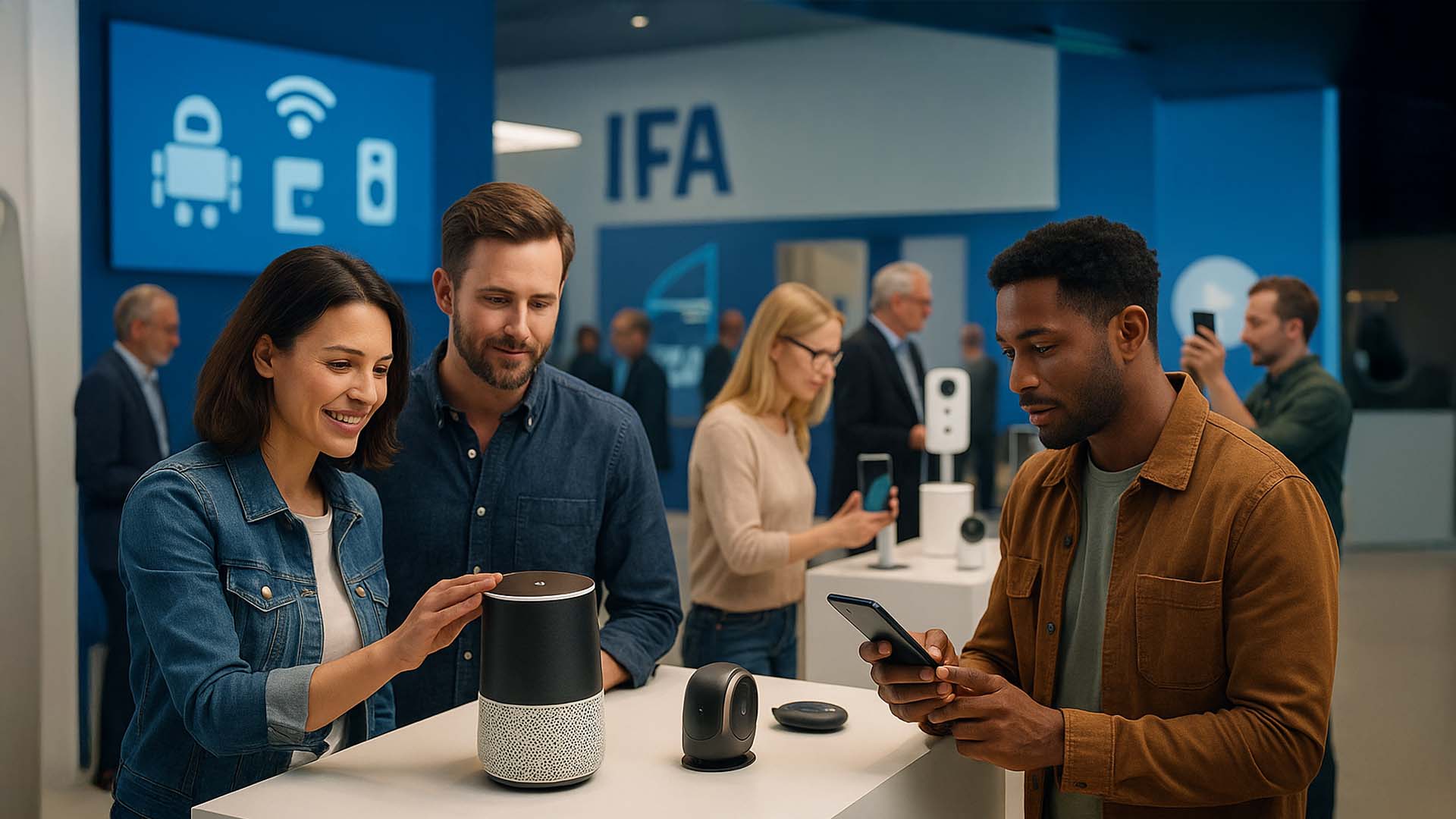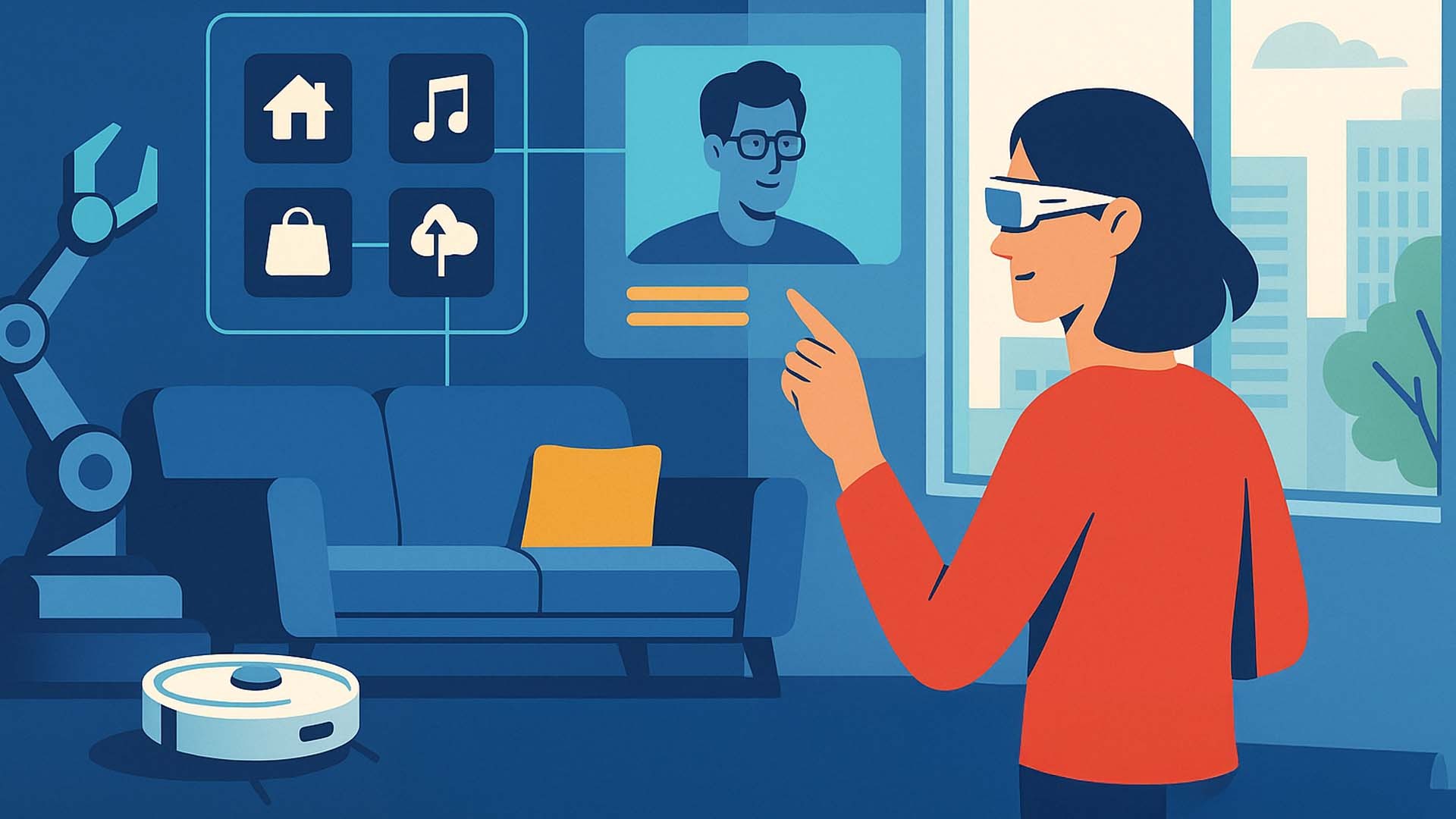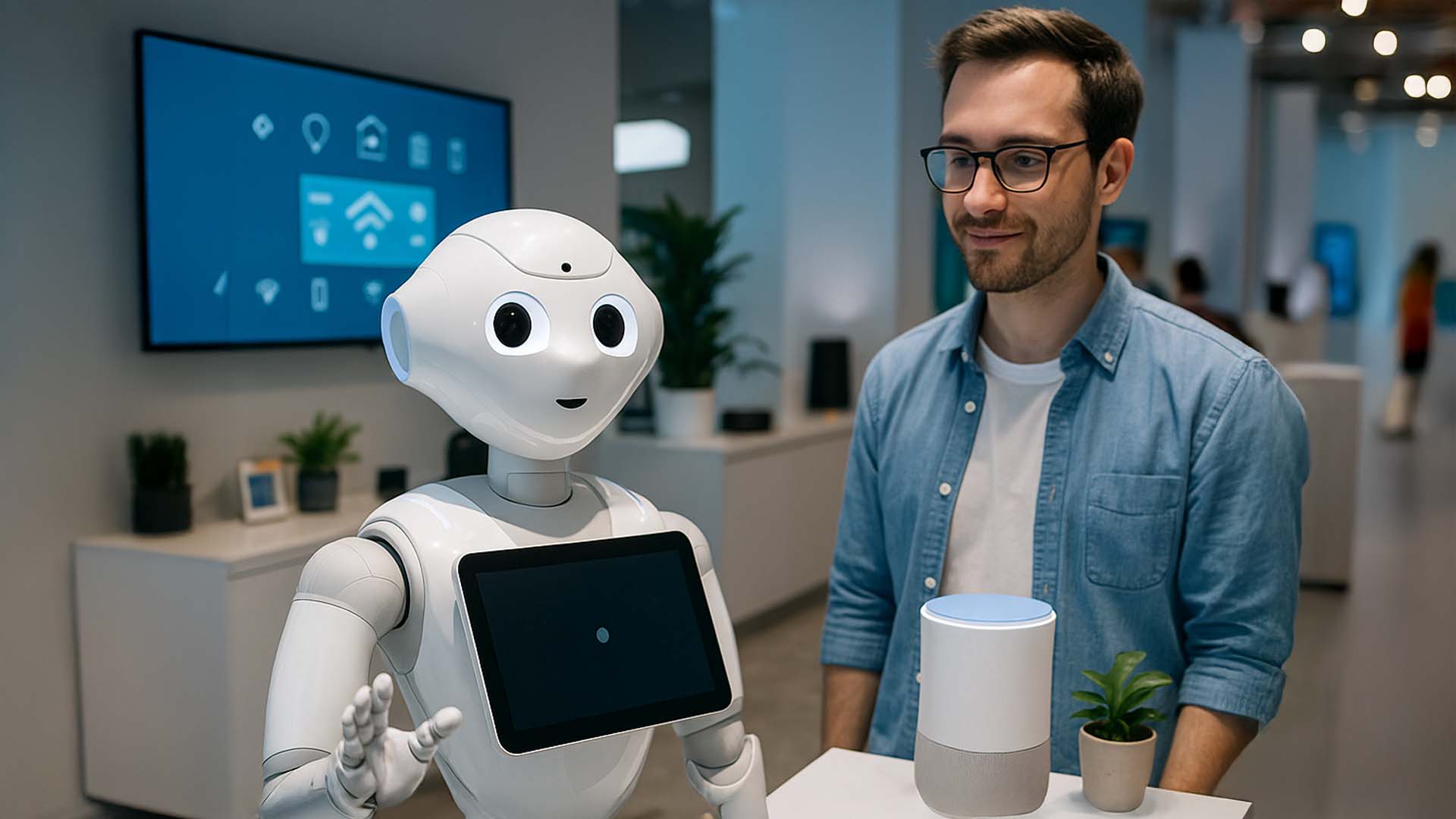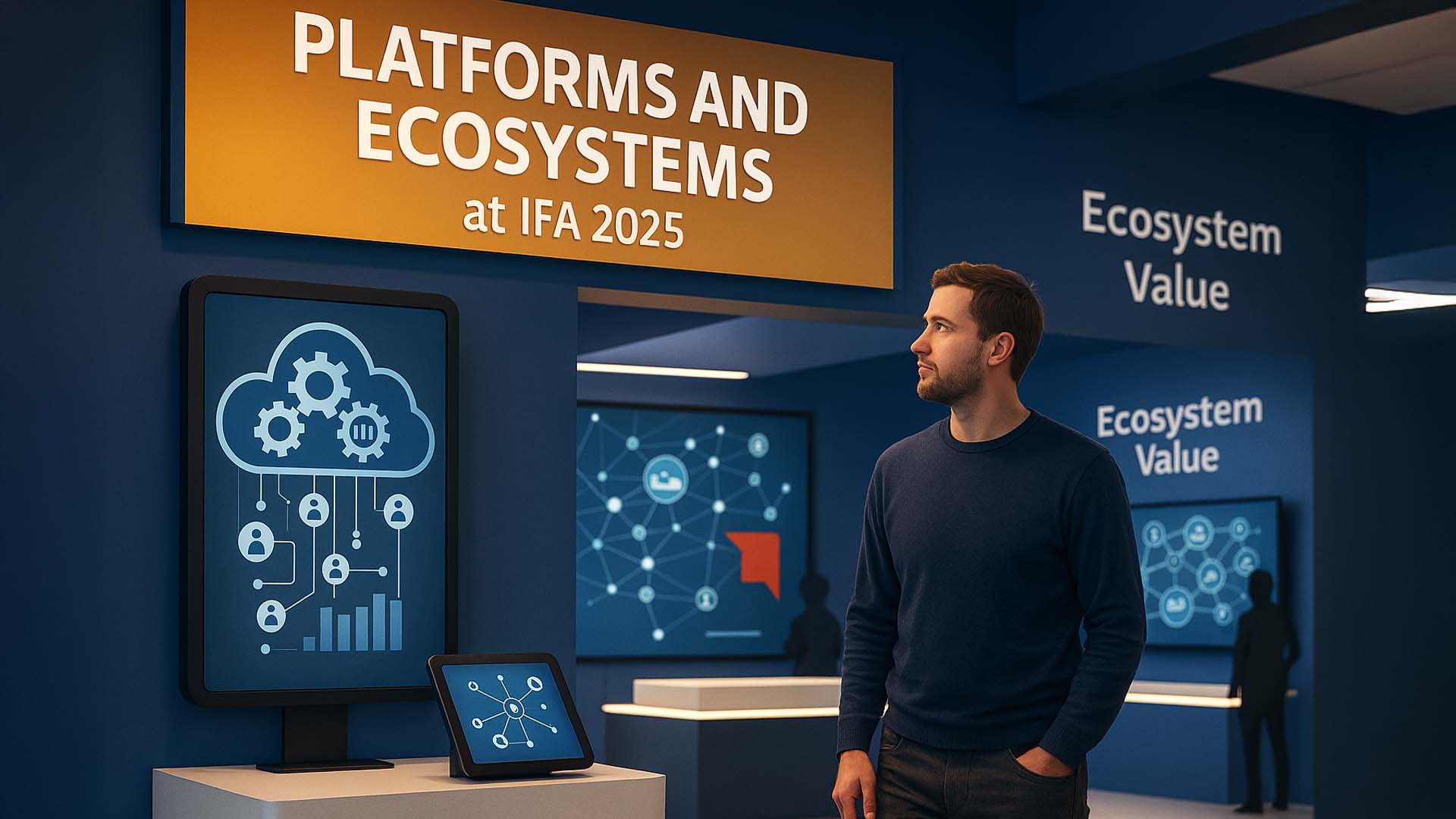Bildnachweis: IFA 2025 / Internationale Funkausstellung Berlin
AI as the Driving Force of Consumer Innovation
Artificial Intelligence has progressed from an additional feature to the structural foundation of consumer technology. At IFA 2025 this transformation becomes visible across all product categories: from household appliances that anticipate user behavior, to wearables that adapt in real time, and mobility systems that optimize energy efficiency without external input. What was once considered “smart” has matured into products capable of continuous learning, adaptation, and interaction.
The technological basis lies in embedding AI directly into chips and edge devices. Products no longer depend entirely on cloud infrastructures but increasingly run complex models locally. This reduces latency, strengthens privacy, and enables greater autonomy in everyday consumer products. From a systems perspective, this represents a democratization of intelligence – computing power is embedded directly into the environment of the consumer.
Economically, AI integration reshapes business models in consumer electronics. Competition is no longer limited to hardware specifications, but extends to ecosystems of AI-enabled services. Continuous updates, personalization, and adaptive functions are becoming decisive factors in long-term customer relationships and revenue growth.
- AI projected to be embedded in 90% of consumer devices by 2030 (McKinsey forecast)
- Edge computing reduces cloud dependency and enables faster, safer products
- Smart home appliances show measurable energy efficiency gains of up to 30%
- Economic models shift from hardware focus to service-driven ecosystems
- Edge-based AI strengthens consumer trust by limiting sensitive data transfer
Research in human-computer interaction supports this trajectory. Studies show that users respond positively to systems that anticipate needs while preserving transparency and control. The design challenge is to ensure that AI functions as an enabler without diminishing human agency. Products at IFA 2025 reflect this balance by making AI visible and understandable, not hidden.
Concrete examples underline this development: refrigerators generate meal plans based on user preferences, washing machines calculate optimal water use, and wearables continuously analyze biometric data to personalize training recommendations. AI becomes both practical and experiential, blending convenience with health and efficiency gains.
Looking ahead, AI will not only redefine products but entire consumer environments. Homes, vehicles, and urban infrastructures will increasingly act as adaptive ecosystems. IFA 2025 provides an early impression of this shift: intelligence is no longer an accessory, it has become the central DNA of consumer innovation.

AI-enabled consumer innovations on display at IFA 2025
Illustration: Visoric GmbH
Artificial Intelligence emerges as the common denominator across sectors – from kitchen appliances to mobility concepts. This breadth of integration underlines that AI is no longer a niche, but a transversal capability. As we move to the next chapter, this transformation connects directly to the rise of immersive technologies: 3D XR bridging the gap between physical products and digital layers.
3D XR Bridging Virtual and Real Worlds
The integration of Artificial Intelligence into consumer products lays the groundwork for another defining transformation: the merging of virtual and physical spaces. At IFA 2025, 3D Extended Reality (XR) emerges not as a futuristic concept but as a tangible consumer reality. Devices once limited to entertainment or niche applications are now entering households, education, healthcare, and retail.
3D XR enhances physical objects by embedding them into interactive digital layers. Smart glasses overlay contextual information in daily life, immersive shopping connects e-commerce with physical behavior, and in education, XR provides environments for active learning and simulation. The message is clear: XR is no longer an accessory but a component of functional value creation.
From a research perspective, XR does not simply simulate but extends human perception and action. Studies in cognitive science and human-computer interaction confirm that immersive environments can amplify learning and memory when applied meaningfully. Companies integrating XR elements into products are not only technologically advanced, they are applying neurocognitive insights into marketable solutions.
- XR technologies evolve from niche into everyday consumer applications
- Smart glasses and immersive interfaces transform commerce, education, and healthcare
- 3D XR provides new forms of product and brand experience beyond visual effects
- Research shows immersive environments significantly improve memory retention
- Market adoption accelerates as XR integrates with AI-driven personalization
The transition visible at IFA 2025 highlights a key turning point: products once labeled as prototypes now enter market-ready production. Standards are also emerging, ensuring interoperability between XR systems and platforms, lowering barriers for consumers and developers alike.
AI plays a critical role in this process. Without adaptive intelligence, XR systems remain static. With AI-driven analytics and personalization, immersive environments become dynamic, responsive, and tailored to individual needs. This convergence of XR and AI defines a new paradigm in consumer experience: interactive ecosystems, not isolated devices.
Concrete showcases at IFA 2025 illustrate this trajectory: AR-based navigation glasses, virtual fitting rooms, and medical XR platforms that simulate patient-specific anatomy for treatment planning. Each example demonstrates that XR is not merely a visual extension, but a functional bridge linking data, perception, and human decision-making.

3D XR bridging everyday life with immersive digital layers
Illustration: Visoric GmbH
XR thus extends beyond entertainment to become a practical and cognitive tool. As IFA 2025 demonstrates, the immersive layer of daily life is forming around us, quietly shifting expectations of how consumers learn, shop, work, and connect. This expansion of human perception prepares the ground for the next focus of transformation: robotics, where digital intelligence translates into physical capability.
Robotics as the Extension of Human Action
The progression from Artificial Intelligence to Extended Reality creates the foundation for another decisive transformation: robotics as the physical extension of human intention. At IFA 2025, robotics is no longer confined to industrial halls. Instead, domestic, service-oriented, and assistive robots are presented as market-ready consumer products. This shift highlights how digital intelligence is embodied into physical machines.
Robotics demonstrates the convergence of mechanical engineering, sensor technology, and AI-driven decision-making. Service robots in households, mobile companions for elderly care, and autonomous delivery units illustrate the breadth of applications. Unlike the early generation of programmable machines, these systems act contextually, adapt to environments, and interact with humans on intuitive levels.
From a research perspective, this development represents a shift from automation to collaboration. Human-robot interaction studies underline that effective collaboration requires not only functional accuracy but also trust and transparency. Robots must be perceived as reliable partners, not as opaque systems, to achieve acceptance in daily life.
- Robotics enters consumer markets with assistive, domestic, and service applications
- Integration of AI transforms robots from programmable machines into adaptive agents
- Human-robot interaction research emphasizes trust and transparency as key factors
- Healthcare and elderly care identified as early adoption sectors for assistive robots
- Robotics bridges digital intelligence with tangible, physical action in everyday environments
Examples from IFA 2025 illustrate this transition vividly: humanoid assistants capable of guiding visitors through exhibitions, robotic vacuum cleaners enhanced with AI-driven environmental mapping, and companion robots equipped with emotion-recognition to support vulnerable groups. These cases highlight both technical capability and societal relevance.
The economic implications are considerable. Robotics in consumer markets is projected to grow exponentially as costs decline and modular systems become standard. Ecosystems of services, maintenance, and upgrades are emerging, mirroring the shift already visible in AI-powered consumer electronics. This creates not only new products but entire value chains around robotic ecosystems.
Looking beyond immediate applications, robotics represents a redefinition of labor and domestic infrastructure. The concept of “hybrid households,” where humans and robots share tasks, becomes increasingly tangible. This reconfiguration poses new social, ethical, and regulatory questions – all of which are beginning to surface in the discussions surrounding IFA 2025.

Robotics entering consumer environments at IFA 2025
Illustration: Visoric GmbH
Robotics thus emerges as the material dimension of digital intelligence. While AI provides cognition and XR expands perception, robotics delivers action. IFA 2025 showcases how these technologies converge into hybrid ecosystems, where digital systems not only calculate and visualize but also move, carry, and support. This development sets the stage for the next chapter: smart living, where these capabilities are woven into the fabric of everyday environments.
Smart Living and the Connected Home
The convergence of AI, XR, and robotics finds one of its most immediate expressions in the concept of smart living. At IFA 2025, the connected home is presented not as a futuristic scenario but as a functioning ecosystem of interoperable devices and services. Here, technology becomes infrastructure: invisible, reliable, and tailored to individual needs.
The smart home sector is increasingly characterized by seamless integration rather than isolated solutions. Appliances communicate with energy grids, lighting adapts to biometric signals, and security systems interact with environmental sensors. The consumer no longer manages individual devices but orchestrates environments that respond to context and behavior.
Research underscores the profound social implications of these systems. Studies in environmental psychology suggest that adaptive environments influence well-being, productivity, and even interpersonal relationships. Smart living thus extends beyond convenience, positioning itself as a catalyst for sustainable lifestyles and healthier living conditions.
- Smart living evolves from isolated devices to connected ecosystems
- Integration with energy grids enhances sustainability and efficiency
- Adaptive environments influence well-being and productivity
- Consumer interaction shifts from device management to ecosystem orchestration
- Health, sustainability, and security emerge as dominant drivers of adoption
Concrete showcases at IFA 2025 include integrated home energy systems that automatically adjust based on dynamic tariffs, wellness applications that regulate indoor climate to support sleep cycles, and AI-driven kitchen systems that optimize nutrition while minimizing food waste. These examples highlight the dual promise of efficiency and personalization.
Economically, the connected home represents a shift towards platform-based business models. Companies compete not only on device design but on the openness, reliability, and adaptability of their ecosystems. Interoperability standards are critical in ensuring consumer trust and preventing technological fragmentation.
The long-term vision is clear: homes are transforming into intelligent infrastructures that integrate with broader urban systems. Smart living thus becomes a node in a larger network of smart cities, where data flows seamlessly between private and public environments, creating a continuum of adaptive intelligence.

Connected home and adaptive ecosystems showcased at IFA 2025
Illustration: Visoric GmbH
The vision of smart living expands the boundaries of consumer electronics. At IFA 2025, the home becomes a prototype for intelligent environments, integrating efficiency, health, and sustainability into daily life. This shift prepares the ground for the next perspective: the digital economy, where platforms, ecosystems, and data infrastructures redefine value creation.
The Digital Economy and Platform Models
The integration of AI, XR, robotics, and smart living culminates in a broader transformation: the rise of a digital economy based on platform models. At IFA 2025, this shift becomes visible in the strategies of leading manufacturers and service providers. Products are no longer designed as isolated devices but as entry points into data-driven ecosystems.
Platform models enable continuous value creation beyond the point of sale. Devices generate data, which fuels services, updates, and personalized offerings. The economic logic is cyclical: the more consumers interact with a product, the more valuable the ecosystem becomes. For companies, this creates recurring revenue streams and long-term relationships rather than one-time sales.
From a scientific perspective, the platform economy represents a structural change in how innovation diffuses. Studies in economic sociology emphasize that platforms shape markets not only technologically but institutionally, by controlling standards, access, and trust. The dynamics observed at IFA 2025 reflect this structural power shift.
- Platform models transform products into gateways to ecosystems
- Data-driven services create recurring revenue and stronger consumer loyalty
- Platform governance influences standards, interoperability, and access
- Consumers gain personalization but face new questions of data sovereignty
- IFA 2025 highlights how global companies compete on ecosystem design, not hardware alone
Concrete examples underline this development: smart speakers become hubs for digital services, wearables provide continuous health data for integrated insurance platforms, and mobility devices link into multimodal transportation networks. Each product functions less as a stand-alone tool and more as a node within a larger digital infrastructure.
For consumers, this creates both opportunities and challenges. Personalized services enhance convenience and efficiency, but data ownership and algorithmic transparency remain unresolved issues. Research on digital ethics and governance warns of potential imbalances between corporate control and individual autonomy.
The platform economy thus extends beyond commerce into questions of societal design. IFA 2025 makes visible that digital infrastructures are not neutral – they embody values, priorities, and institutional arrangements. Understanding and shaping these dynamics becomes a core task for industry, policymakers, and consumers alike.

Platforms and ecosystems redefining value creation at IFA 2025
Illustration: Visoric GmbH
The digital economy redefines competition: not between individual devices, but between ecosystems of services, standards, and trust. At IFA 2025, this shift becomes evident across industries. The next step is to analyze how these narratives are communicated to the public – a perspective offered in the following video chapter.
Visual Insights from IFA 2025
Videos provide immediate evidence of the dynamics of the trade fair: they show not only products but also staging, interaction, and audience response. In doing so, they complement analytical findings with contextual signals such as event pacing, density of innovations, and the narrative focus of the exhibitors.
The featured video condenses key moments of IFA 2025: product demonstrations, live explanations by the teams, and visitor reactions. For analysis, particularly relevant are sequences where technical performance promises are linked to concrete use cases and where competition for attention is reflected in clear messaging.
From a research perspective, the material is well suited for qualification analyses: Which argumentation patterns do exhibitors use (performance, sustainability, security, interoperability)? Which interface paradigms are demonstrated (voice-, gaze-, or gesture-based)? Which signals point to maturity levels (prototype vs. production readiness)?
Visual impressions of IFA 2025 – product demonstrations, interfaces, visitor reactions
Source: IFA 2025 / Visoric Newsroom
About the Author and the Munich Expert Team of VISORIC GmbH
The perspectives presented in this analysis are based on the direct observations and analytical expertise of Ulrich Buckenlei, accredited media representative and industry analyst at IFA 2025. His task is to connect technological signals with broader social and economic trends and make them accessible to professional audiences in science, business, and politics.
For more than fifteen years, Buckenlei has been working at the intersection of research, applied technology, and communication. His focus ranges from artificial intelligence and robotics to immersive 3D XR environments. His analytical approach is grounded in a combination of scientific methods, in-depth industry knowledge, and direct reporting from international technology events such as IFA.
This work is supported by the Munich expert team of VISORIC GmbH, specializing in AI, robotics, and XR. The group combines programming and technical implementation with conceptual design and consulting. The expertise of VISORIC GmbH is built on interdisciplinary collaboration: engineers, designers, and analysts work together to develop insights and solutions for institutions and enterprises.
- Research-based analysis of trends in AI, robotics, and XR
- Conceptual design and prototyping of innovative applications
- Technical implementation through programming and system integration
- Strategic consulting for companies and institutions across various industries
- More than fifteen years of experience bridging research and practice
The guiding principle of the team is not promotion, but orientation. Their goal is to provide a scientifically grounded framework for decision-making in times of technological transformation. Whether it is AI-powered consumer products, robotic assistance, or immersive XR interfaces, the team helps to put innovations into context and clarify both their practical and societal implications.
In this role, Ulrich Buckenlei and his Munich expert team at VISORIC GmbH see themselves as mediators between technological development and institutional implementation. Their aim is not to predict a single future but to broaden perspectives on what is possible. By combining critical analysis with applied expertise, they provide orientation in an environment where technological, economic, and cultural transformations are closely intertwined.
Contact Persons:
Ulrich Buckenlei (Creative Director)
Mobile: +49 152 53532871
Email: ulrich.buckenlei@visoric.com
Nataliya Daniltseva (Project Manager)
Mobile: +49 176 72805705
Email: nataliya.daniltseva@visoric.com
Address:
VISORIC GmbH
Bayerstraße 13
D-80335 Munich


